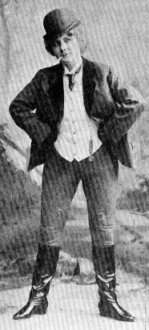Barrison Sisters
The Barrison Sisters were a risqué vaudeville act which performed in the United States and Europe from about 1893 to 1897; in the United States they were advertised as The Wickedest Girls In the World.

History
Lona (Abelone Maria, 1871–1939), Sophia (Sofie Kathrine Theodora, 1877–1906), Inger (Inger Marie, 1878–1918), Olga (Hansine Johanne, 1875–1908) and Gertrude (Gertrud Marie, 1881–1946) Barrison were actual sisters (many "sister" vaudeville acts were not) of Danish-German descent. The five sisters were all born in Copenhagen, Denmark. Along with their mother, the sisters emigrated to the United States in 1886, joining their father, who had earlier made the same journey. Lona Barrison, the oldest of the sisters, had a fleeting theatre experience in Copenhagen as a young girl, and it was she who initially gravitated towards the theatre scene after the family settled in Manhattan, New York City. Later on, she was joined by her siblings. Originally called Bareisen, they anglicized their surname, thus becoming the Barrison Sisters. The five blond and curly-haired siblings were said to sing in high squeaky voices and dance with middling ability. They achieved notoriety, however, by ingenious use of double entendres on stage.
Actress Pearl Eytinge initially produced them and wrote a comedietta for them called Mr Cupid. Her manager, Danish-born William (Wilhelm Ludvig) Fleron (1858–1935), took over the management of the sisters and married Lona in 1893.[1]
In their most famous act, the sisters would dance, raising their skirts slightly above their knees, and ask the audience, "Would you like to see my pussy?" When they had coaxed the audience into an enthusiastic response, they would raise up their skirts, revealing that each sister was wearing underwear of their own manufacture that had a live kitten secured over the crotch.
After their success in Europe in the mid-1890s, scores of troupes purporting to be "sisters" followed in their footsteps, among them the British Machinson Sisters. The Barrison Sisters broke up in 1897, but both Gertrude and Lona went on to have successful solo careers on the stage. Gertrude, the youngest and perhaps most talented of them all, became a groundbreaking modern dancer in Vienna, where she lived for two decades, married to Carl Hollitzer (separated in 1910), a renowned Austrian painter. She was the last to die—in 1946 in Copenhagen.
The Barrison Sisters came to renewed public attention in the first decade of the 21st century when they were featured on the label of Five Wives Vodka,[2] produced by Ogden's Own Distillery in Utah;[3] the vodka was initially rejected for sale in the adjacent control state of Idaho,[4] an action for which the Idaho State Liquor Division was later awarded a 2013 Muzzles Award by the Thomas Jefferson Center for the Protection of Free Expression.[5]
References
- "Some Suicidal Sisters". The Argonaut. XXXIX (1024): 6. 26 October 1896.
- http://www.idahostatesman.com/2012/06/01/2137818/utah-distiller-may-sue-idaho.html
- "Five Wives Vodka - Ogden's Own Distillery". Ogdensown.com. Archived from the original on 2013-09-06. Retrieved 2013-09-15.
- Farnham, Alan (2012-05-30). "Does Five Wives Vodka Offend Mormons? - ABC News". Abcnews.go.com. Retrieved 2013-09-15.
- "The Thomas Jefferson Center For the Protection of Free Expression » 2013 Muzzles » The Thomas Jefferson Center For the Protection of Free Expression". Tjcenter.org. 2012-12-01. Archived from the original on 2013-06-05. Retrieved 2013-09-15.
External links
| Wikimedia Commons has media related to Barrison Sisters. |
- The Old Spice Girls by Richard Smithson
- Text of one of their performances